The Cambridge History of Japan, Vol. 3: Medieval Japan
Подождите немного. Документ загружается.

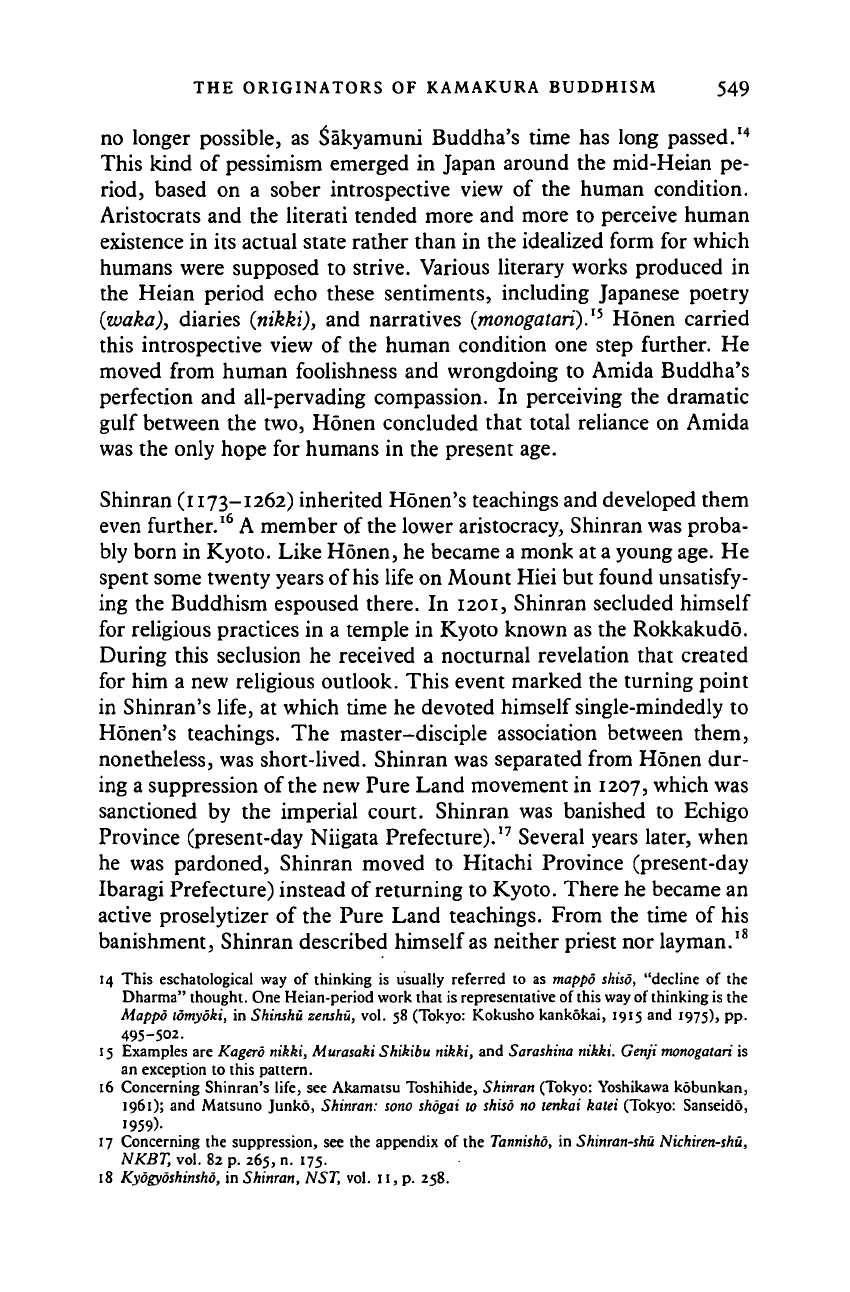
THE ORIGINATORS OF KAMAKURA BUDDHISM 549
no longer possible, as Sakyamuni Buddha's time has long passed.
14
This kind of pessimism emerged in Japan around the mid-Heian pe-
riod, based on a sober introspective view of the human condition.
Aristocrats and the literati tended more and more to perceive human
existence in its actual state rather than in the idealized form for which
humans were supposed to strive. Various literary works produced in
the Heian period echo these sentiments, including Japanese poetry
(waka),
diaries (nikki), and narratives (monogatari).
15
Honen carried
this introspective view of the human condition one step further. He
moved from human foolishness and wrongdoing to Amida Buddha's
perfection and all-pervading compassion. In perceiving the dramatic
gulf between the two, Honen concluded that total reliance on Amida
was the only hope for humans in the present age.
Shinran (1173-1262) inherited Honen's teachings and developed them
even further.
16
A member of the lower aristocracy, Shinran was proba-
bly born in Kyoto. Like Honen, he became a monk at a young age. He
spent some twenty years of his life on Mount Hiei but found unsatisfy-
ing the Buddhism espoused there. In 1201, Shinran secluded himself
for religious practices in a temple in Kyoto known as the Rokkakudo.
During this seclusion he received a nocturnal revelation that created
for him a new religious outlook. This event marked the turning point
in Shinran's life, at which time he devoted himself single-mindedly to
Honen's teachings. The master-disciple association between them,
nonetheless, was short-lived. Shinran was separated from Honen dur-
ing a suppression of the new Pure Land movement in 1207, which was
sanctioned by the imperial court. Shinran was banished to Echigo
Province (present-day Niigata Prefecture).
17
Several years later, when
he was pardoned, Shinran moved to Hitachi Province (present-day
Ibaragi Prefecture) instead of returning to Kyoto. There he became an
active proselytizer of the Pure Land teachings. From the time of his
banishment, Shinran described himself as neither priest nor layman.
18
14 This eschatological way of thinking is usually referred to as mappo shiso, "decline of the
Dharma" thought. One Heian-period work that is representative of this way of thinking is the
Mappo lomyoki, in Shinshu zenshu, vol. 58 (Tokyo: Kokusho kankokai, 1915 and 1975), pp.
495-502.
15 Examples are Kagero nikki, Murasaki Shikibu nikki, and Sarashina nikki. Genji
monogatari
is
an exception to this pattern.
16 Concerning Shinran's life, see Akamatsu Toshihide, Shinran (Tokyo: Yoshikawa kobunkan,
1961);
and Matsuno Junko, Shinran: sono shogai to shiso no lenkai katei (Tokyo: Sanseido,
1959)-
17 Concerning the suppression, see the appendix of the Tannisho, in Shinran-shu Nichiren-shu,
NKBT,
vol. 82 p. 265, n. 175.
18 Kyogyoshinsho, in Shinran, NST, vol. 11, p. 258.
Cambridge Histories Online © Cambridge University Press, 2008
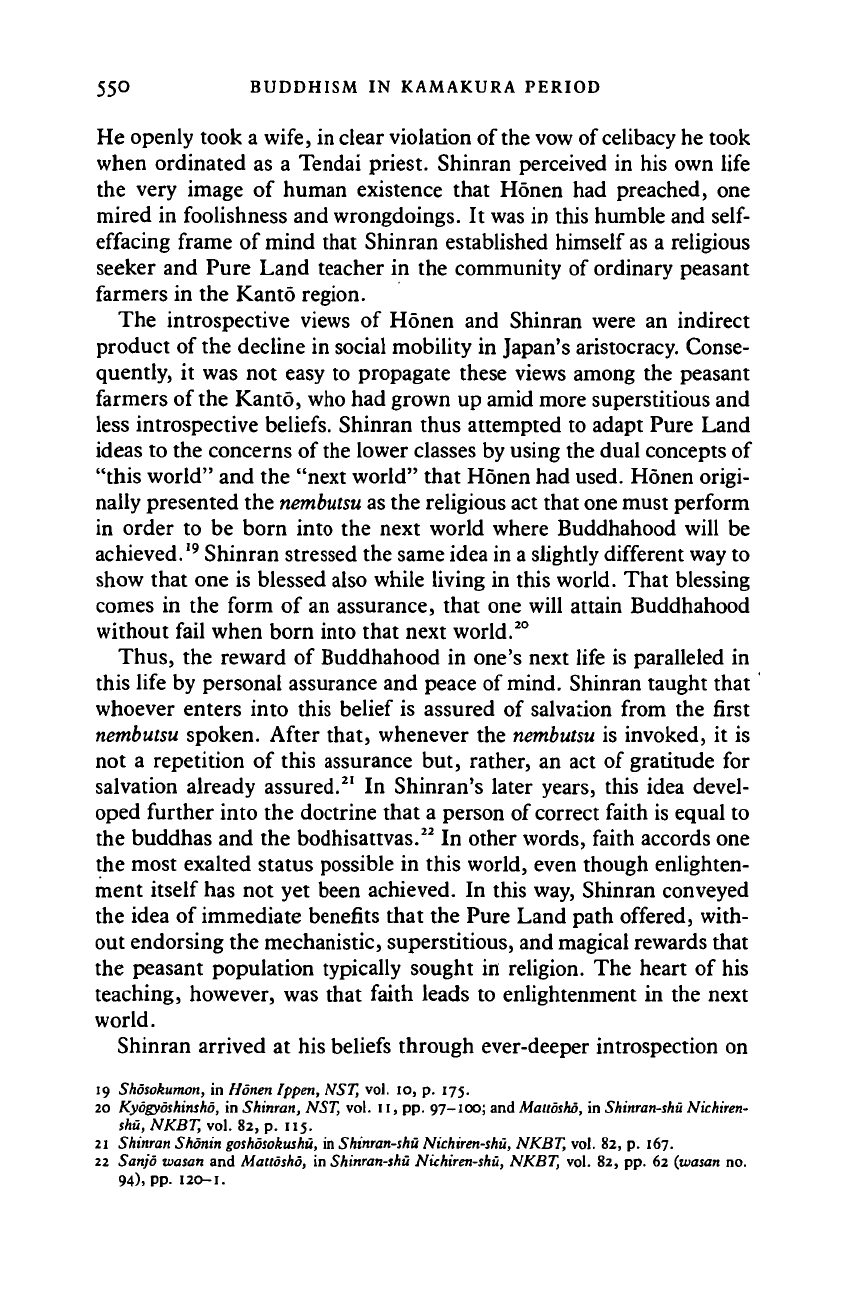
55° BUDDHISM IN KAMAKURA PERIOD
He openly took a wife, in clear violation of
the
vow of celibacy he took
when ordinated as a Tendai priest. Shinran perceived in his own life
the very image of human existence that Honen had preached, one
mired in foolishness and wrongdoings. It was in this humble and
self-
effacing frame of mind that Shinran established himself
as
a religious
seeker and Pure Land teacher in the community of ordinary peasant
farmers in the Kan to region.
The introspective views of Honen and Shinran were an indirect
product of the decline in social mobility in Japan's aristocracy. Conse-
quently, it was not easy to propagate these views among the peasant
farmers of the Kanto, who had grown up amid more superstitious and
less introspective beliefs. Shinran thus attempted to adapt Pure Land
ideas to the concerns of
the
lower classes by using the dual concepts of
"this world" and the "next world" that Honen had used. Honen origi-
nally presented the
nembutsu
as the religious act that one must perform
in order to be born into the next world where Buddhahood will be
achieved.
19
Shinran stressed the same idea in
a
slightly different way to
show that one is blessed also while living in this world. That blessing
comes in the form of an assurance, that one will attain Buddhahood
without fail when born into that next world.
20
Thus,
the reward of Buddhahood in one's next life is paralleled in
this life by personal assurance and peace of mind. Shinran taught that
whoever enters into this belief is assured of salvation from the first
nembutsu
spoken. After that, whenever the
nembutsu
is invoked, it is
not a repetition of this assurance but, rather, an act of gratitude for
salvation already assured.
21
In Shinran's later years, this idea devel-
oped further into the doctrine that a person of correct faith is equal to
the buddhas and the bodhisattvas.
22
In other words, faith accords one
the most exalted status possible in this world, even though enlighten-
ment itself has not yet been achieved. In this way, Shinran conveyed
the idea of immediate benefits that the Pure Land path offered, with-
out endorsing the mechanistic, superstitious, and magical rewards that
the peasant population typically sought in religion. The heart of his
teaching, however, was that faith leads to enlightenment in the next
world.
Shinran arrived at his beliefs through ever-deeper introspection on
19
Shosokumon, in Honen Ippen, NST, vol. 10, p. 175.
20 Kyogyoshinshd,
in
Shinran,
NST, vol. 11, pp.
97-100; and Maiidsho,
in
Shinran-shu Nichiren-
shu,
NKBT,
vol. 82, p. 115.
21
Shinran Shonin
goshdsokushu,
in
Shinran-shu
Nichiren-shu,
NKBT, vol. 82, p. 167.
22
Sanjo wasan and Mattosho, in
Shinran-shu
Nichiren-shu, NKBT, vol. 82, pp. 62 (wasan no.
94),
pp.
120-1.
Cambridge Histories Online © Cambridge University Press, 2008
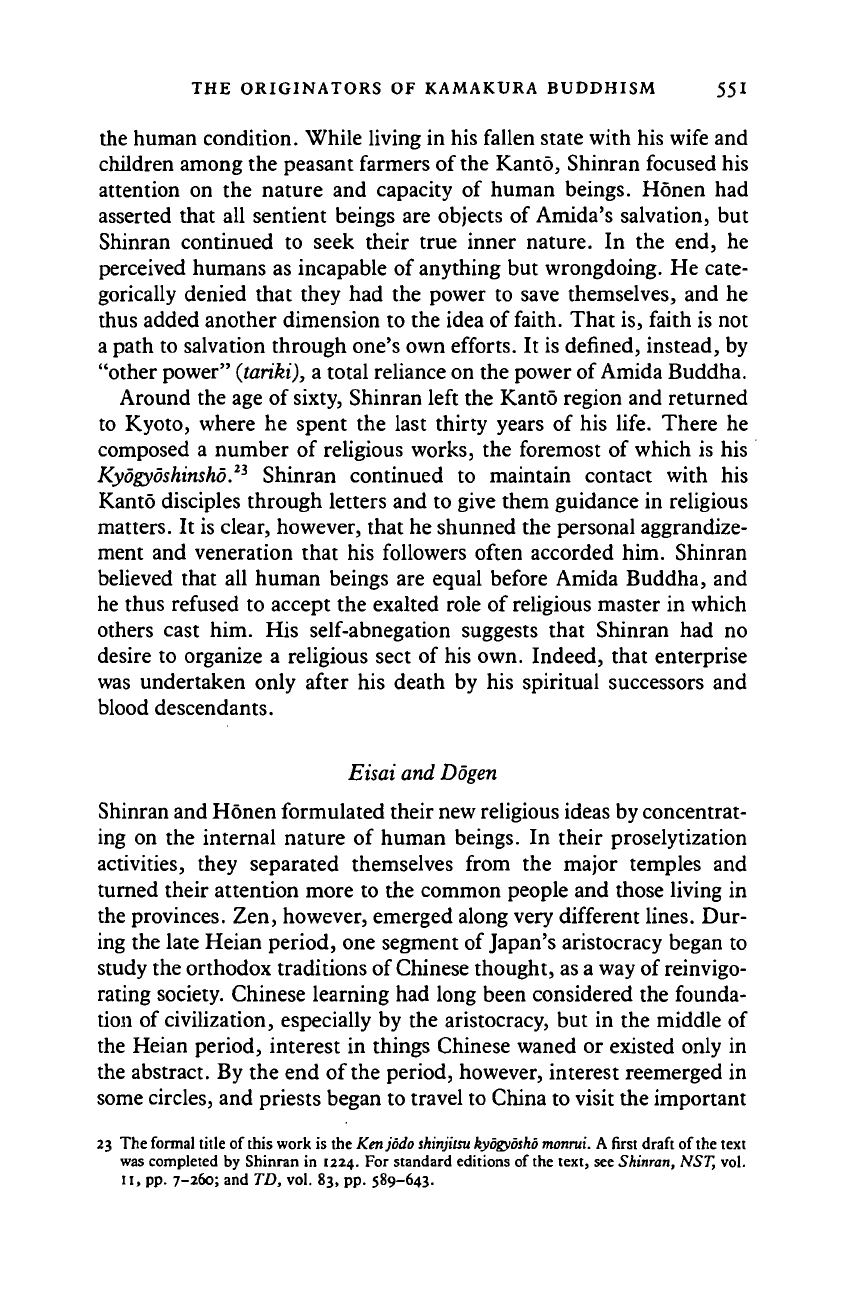
THE ORIGINATORS OF KAMAKURA BUDDHISM 55I
the human condition. While living in his fallen state with his wife and
children among the peasant farmers of the Kanto, Shinran focused his
attention on the nature and capacity of human beings. Honen had
asserted that all sentient beings are objects of Amida's salvation, but
Shinran continued to seek their true inner nature. In the end, he
perceived humans as incapable of anything but wrongdoing. He cate-
gorically denied that they had the power to save themselves, and he
thus added another dimension to the idea of faith. That is, faith is not
a path to salvation through one's own efforts. It is defined, instead, by
"other power" (tariki), a total reliance on the power of Amida Buddha.
Around the age of sixty, Shinran left the Kanto region and returned
to Kyoto, where he spent the last thirty years of his life. There he
composed a number of religious works, the foremost of which is his
Kyogyoshinsho.
2
* Shinran continued to maintain contact with his
Kanto disciples through letters and to give them guidance in religious
matters. It is clear, however, that he shunned the personal aggrandize-
ment and veneration that his followers often accorded him. Shinran
believed that all human beings are equal before Amida Buddha, and
he thus refused to accept the exalted role of religious master in which
others cast him. His self-abnegation suggests that Shinran had no
desire to organize a religious sect of his own. Indeed, that enterprise
was undertaken only after his death by his spiritual successors and
blood descendants.
Eisai and Dogen
Shinran and Honen formulated their new religious ideas by concentrat-
ing on the internal nature of human beings. In their proselytization
activities, they separated themselves from the major temples and
turned their attention more to the common people and those living in
the provinces. Zen, however, emerged along very different lines. Dur-
ing the late Heian period, one segment of Japan's aristocracy began to
study the orthodox traditions of Chinese thought, as a way of reinvigo-
rating society. Chinese learning had long been considered the founda-
tion of civilization, especially by the aristocracy, but in the middle of
the Heian period, interest in things Chinese waned or existed only in
the abstract. By the end of the period, however, interest reemerged in
some circles, and priests began to travel to China to visit the important
23 The formal title of this work is the Kenjodo
shinjitsu kyogyosho
monrui.
A first draft of
the
text
was completed by Shinran in 1224. For standard editions of the text, see Shinran, NST, vol.
11,
pp. 7-260; and TD, vol. 83, pp. 589-643.
Cambridge Histories Online © Cambridge University Press, 2008
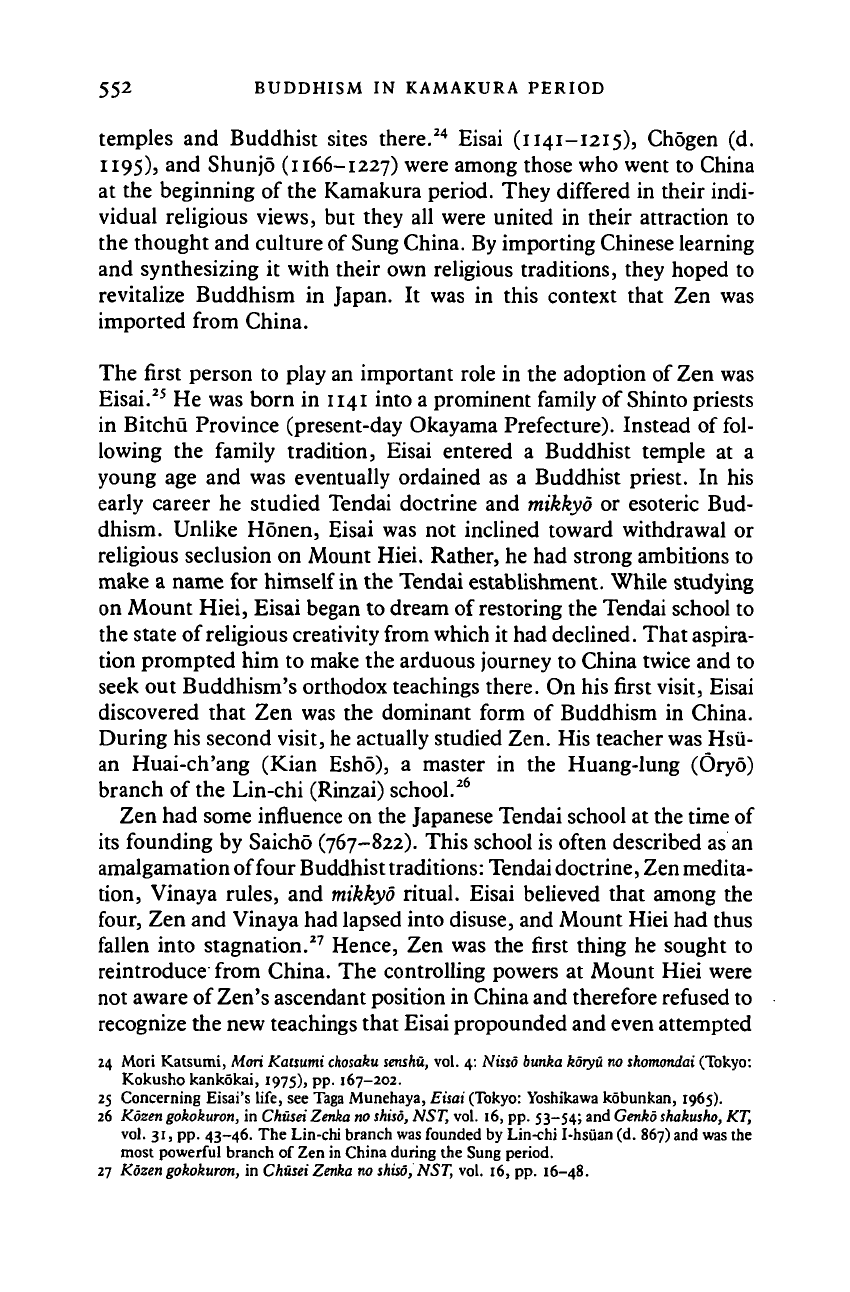
552 BUDDHISM IN KAMAKURA PERIOD
temples and Buddhist sites there.
24
Eisai (1141-1215), Chogen (d.
1195)3
an
d Shunjo (1166-1227) were among those who went to China
at the beginning of the Kamakura period. They differed in their indi-
vidual religious views, but they all were united in their attraction to
the thought and culture of Sung China. By importing Chinese learning
and synthesizing it with their own religious traditions, they hoped to
revitalize Buddhism in Japan. It was in this context that Zen was
imported from China.
The first person to play an important role in the adoption of Zen was
Eisai.
25
He was born in 1141 into a prominent family of Shinto priests
in Bitchu Province (present-day Okayama Prefecture). Instead of fol-
lowing the family tradition, Eisai entered a Buddhist temple at a
young age and was eventually ordained as a Buddhist priest. In his
early career he studied Tendai doctrine and mikkyo or esoteric Bud-
dhism. Unlike Honen, Eisai was not inclined toward withdrawal or
religious seclusion on Mount Hiei. Rather, he had strong ambitions to
make a name for himself in the Tendai establishment. While studying
on Mount Hiei, Eisai began to dream of restoring the Tendai school to
the state of religious creativity from which it had declined. That aspira-
tion prompted him to make the arduous journey to China twice and to
seek out Buddhism's orthodox teachings there. On his first visit, Eisai
discovered that Zen was the dominant form of Buddhism in China.
During his second visit, he actually studied Zen. His teacher was Hsii-
an Huai-ch'ang (Kian Esho), a master in the Huang-lung (Oryo)
branch of the Lin-chi (Rinzai) school.
26
Zen had some influence on the Japanese Tendai school at the time of
its founding by Saicho (767-822). This school is often described as an
amalgamation of four Buddhist traditions: Tendai
doctrine,
Zen medita-
tion, Vinaya rules, and mikkyo ritual. Eisai believed that among the
four, Zen and Vinaya had lapsed into disuse, and Mount Hiei had thus
fallen into stagnation.
27
Hence, Zen was the first thing he sought to
reintroduce from China. The controlling powers at Mount Hiei were
not aware of Zen's ascendant position in China and therefore refused to
recognize the new teachings that Eisai propounded and even attempted
24 Mori Katsumi, Mori Katsumi chosaku senshu, vol. 4: Nisso bunka koryu no shomondai (Tokyo:
Kokusho kankokai, 1975), pp. 167-202.
25 Concerning Eisai's life, see Taga Munehaya, Eisai (Tokyo: Yoshikawa kobunkan, 1965).
26 Kozen gokokuron,
in
Chusei Zenka no
shiso,
NST,
vol. 16, pp. 53-54; and Genko
shakusho,
KT,
vol. 31, pp. 43-46. The Lin-chi branch was founded by Lin-chi I-hsiian (d. 867) and was the
most powerful branch
of
Zen in China during the Sung period.
27 Kozen gokokuron,
in
Chusei Zenka no shiso,
NST,
vol. 16, pp. 16-48.
Cambridge Histories Online © Cambridge University Press, 2008
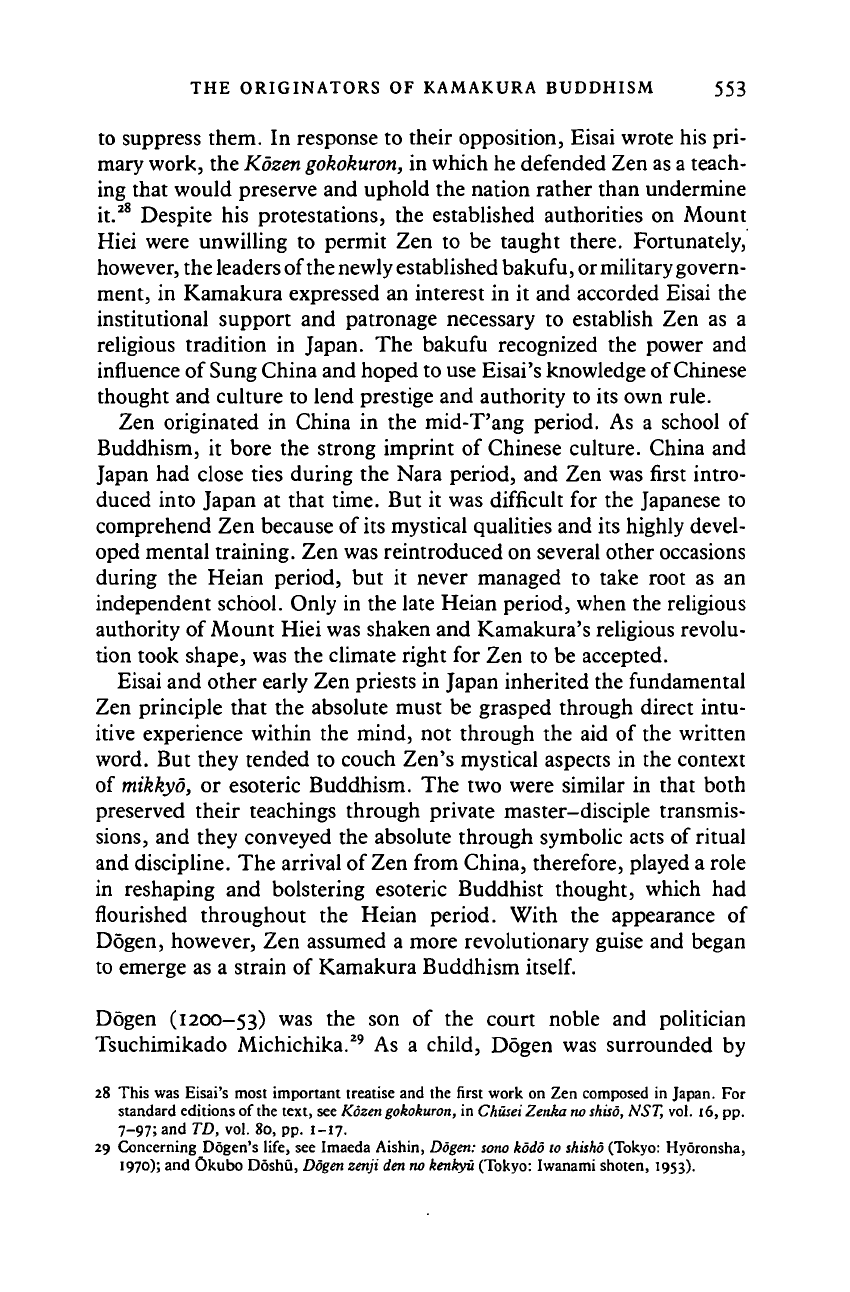
THE ORIGINATORS OF KAMAKURA BUDDHISM 553
to suppress them. In response to their opposition, Eisai wrote his pri-
mary work, the
Kozen
gokokuron,
in which he defended Zen as a teach-
ing that would preserve and uphold the nation rather than undermine
it.
28
Despite his protestations, the established authorities on Mount
Hiei were unwilling to permit Zen to be taught there. Fortunately,
however,
the leaders
of the newly established bakufu, or military govern-
ment, in Kamakura expressed an interest in it and accorded Eisai the
institutional support and patronage necessary to establish Zen as a
religious tradition in Japan. The bakufu recognized the power and
influence of
Sung
China and hoped to use Eisai's knowledge of Chinese
thought and culture to lend prestige and authority to its own rule.
Zen originated in China in the mid-T'ang period. As a school of
Buddhism, it bore the strong imprint of Chinese culture. China and
Japan had close ties during the Nara period, and Zen was first intro-
duced into Japan at that time. But it was difficult for the Japanese to
comprehend Zen because of
its
mystical qualities and its highly devel-
oped mental training. Zen was reintroduced on several other occasions
during the Heian period, but it never managed to take root as an
independent school. Only in the late Heian period, when the religious
authority of Mount Hiei was shaken and Kamakura's religious revolu-
tion took shape, was the climate right for Zen to be accepted.
Eisai and other early Zen priests in Japan inherited the fundamental
Zen principle that the absolute must be grasped through direct intu-
itive experience within the mind, not through the aid of the written
word. But they tended to couch Zen's mystical aspects in the context
of
mikkyo,
or esoteric Buddhism. The two were similar in that both
preserved their teachings through private master-disciple transmis-
sions,
and they conveyed the absolute through symbolic acts of ritual
and discipline. The arrival of Zen from China, therefore, played a role
in reshaping and bolstering esoteric Buddhist thought, which had
flourished throughout the Heian period. With the appearance of
Dogen, however, Zen assumed a more revolutionary guise and began
to emerge as a strain of Kamakura Buddhism
itself.
Dogen (1200-53) was the son of the court noble and politician
Tsuchimikado Michichika.
29
As a child, Dogen was surrounded by
28 This was Eisai's most important treatise and the first work on Zen composed in Japan. For
standard editions of the text, see Kozen gokokuron, in Chuui Zenka no
shiso,
NST, vol. 16, pp.
7-97; and TD, vol. 80, pp. 1-17.
29 Concerning Dogen's life, see Imaeda Aishin, Dogen: sono kodo to
shisho
(Tokyo: Hyoronsha,
1970);
and Okubo Doshu, Dogen zenji den no kenkyu (Tokyo: Iwanami shot en, 1953).
Cambridge Histories Online © Cambridge University Press, 2008
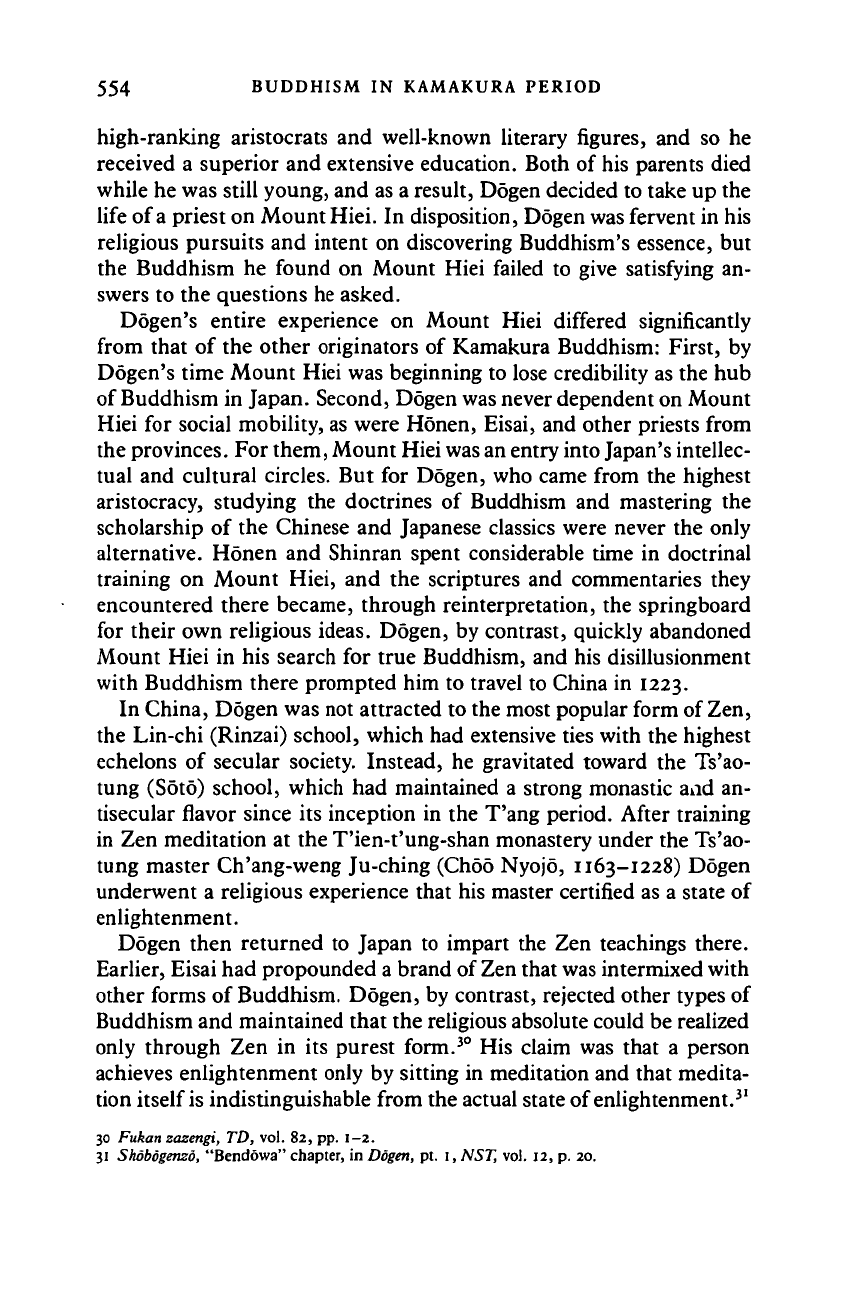
554 BUDDHISM IN KAMAKURA PERIOD
high-ranking aristocrats and well-known literary figures, and so he
received a superior and extensive education. Both of his parents died
while he was still young, and as a result, Dogen decided to take up the
life of a priest on Mount
Hiei.
In disposition, Dogen was fervent in his
religious pursuits and intent on discovering Buddhism's essence, but
the Buddhism he found on Mount Hiei failed to give satisfying an-
swers to the questions he asked.
Dogen's entire experience on Mount Hiei differed significantly
from that of the other originators of Kamakura Buddhism: First, by
Dogen's time Mount Hiei was beginning to lose credibility as the hub
of Buddhism in Japan. Second, Dogen was never dependent on Mount
Hiei for social mobility, as were Honen, Eisai, and other priests from
the provinces. For them, Mount Hiei
was
an entry into Japan's intellec-
tual and cultural circles. But for Dogen, who came from the highest
aristocracy, studying the doctrines of Buddhism and mastering the
scholarship of the Chinese and Japanese classics were never the only
alternative. Honen and Shinran spent considerable time in doctrinal
training on Mount Hiei, and the scriptures and commentaries they
encountered there became, through reinterpretation, the springboard
for their own religious ideas. Dogen, by contrast, quickly abandoned
Mount Hiei in his search for true Buddhism, and his disillusionment
with Buddhism there prompted him to travel to China in 1223.
In China, Dogen was not attracted to the most popular form of Zen,
the Lin-chi (Rinzai) school, which had extensive ties with the highest
echelons of secular society. Instead, he gravitated toward the Ts'ao-
tung (Soto) school, which had maintained a strong monastic and an-
tisecular flavor since its inception in the T'ang period. After training
in Zen meditation at the T'ien-t'ung-shan monastery under the Ts'ao-
tung master Ch'ang-weng Ju-ching (Choo Nyojo, 1163-1228) Dogen
underwent a religious experience that his master certified as a state of
enlightenment.
Dogen then returned to Japan to impart the Zen teachings there.
Earlier, Eisai had propounded
a
brand of Zen that
was
intermixed with
other forms of Buddhism. Dogen, by contrast, rejected other types of
Buddhism and maintained that the religious absolute could be realized
only through Zen in its purest form.
30
His claim was that a person
achieves enlightenment only by sitting in meditation and that medita-
tion itself is indistinguishable from the actual state of enlightenment.
31
30 Fukan zazengi, TD, vol. 82, pp. 1-2.
31 Shobogenzo, "Bendowa" chapter, in Dogen, pt. 1, NST, vol. 12, p. 20.
Cambridge Histories Online © Cambridge University Press, 2008
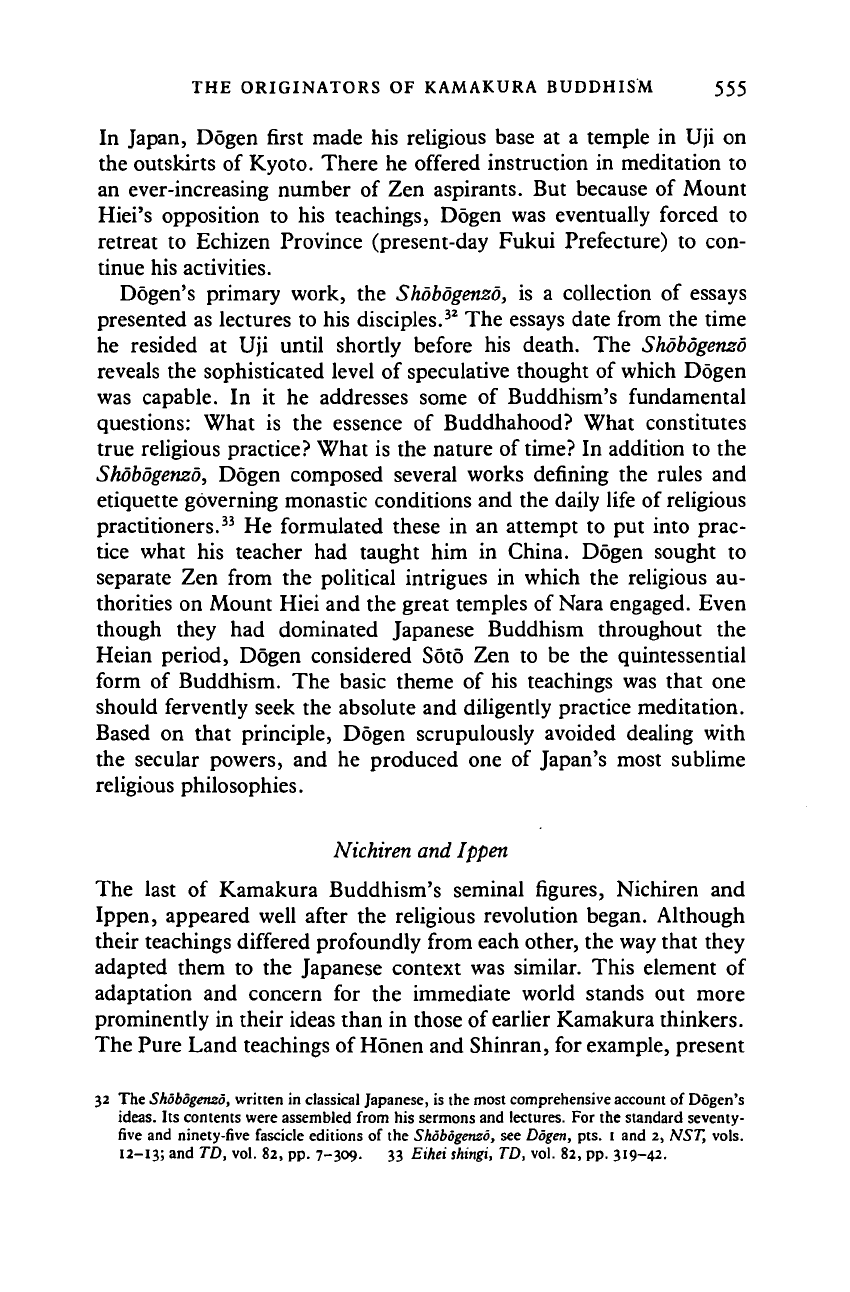
THE ORIGINATORS OF KAMAKURA BUDDHISM 555
In Japan, Dogen first made his religious base at a temple in Uji on
the outskirts of Kyoto. There he offered instruction in meditation to
an ever-increasing number of Zen aspirants. But because of Mount
Hiei's opposition to his teachings, Dogen was eventually forced to
retreat to Echizen Province (present-day Fukui Prefecture) to con-
tinue his activities.
Dogen's primary work, the Shobogenzo, is a collection of essays
presented as lectures to his disciples.
32
The essays date from the time
he resided at Uji until shortly before his death. The Shobogenzo
reveals the sophisticated level of speculative thought of which Dogen
was capable. In it he addresses some of Buddhism's fundamental
questions: What is the essence of Buddhahood? What constitutes
true religious practice? What is the nature of time? In addition to the
Shobogenzo, Dogen composed several works defining the rules and
etiquette governing monastic conditions and the daily life of religious
practitioners.
33
He formulated these in an attempt to put into prac-
tice what his teacher had taught him in China. Dogen sought to
separate Zen from the political intrigues in which the religious au-
thorities on Mount Hiei and the great temples of Nara engaged. Even
though they had dominated Japanese Buddhism throughout the
Heian period, Dogen considered Soto Zen to be the quintessential
form of Buddhism. The basic theme of his teachings was that one
should fervently seek the absolute and diligently practice meditation.
Based on that principle, Dogen scrupulously avoided dealing with
the secular powers, and he produced one of Japan's most sublime
religious philosophies.
Nichiren and Ippen
The last of Kamakura Buddhism's seminal figures, Nichiren and
Ippen, appeared well after the religious revolution began. Although
their teachings differed profoundly from each other, the way that they
adapted them to the Japanese context was similar. This element of
adaptation and concern for the immediate world stands out more
prominently in their ideas than in those of earlier Kamakura thinkers.
The Pure Land teachings of Honen and Shinran, for example, present
32 The
Shobogenzo,
written in classical Japanese, is the most comprehensive account of Dogen's
ideas.
Its contents were assembled from his sermons and lectures. For the standard seventy-
five and ninety-five fascicle editions of the Shobogenzo, see Dogen, pts. 1 and 2, NST, vols.
12-13;
an
d TD, vol. 82, pp. 7-309. 33 Eihei
shingi,
TD, vol. 82, pp. 319-42.
Cambridge Histories Online © Cambridge University Press, 2008
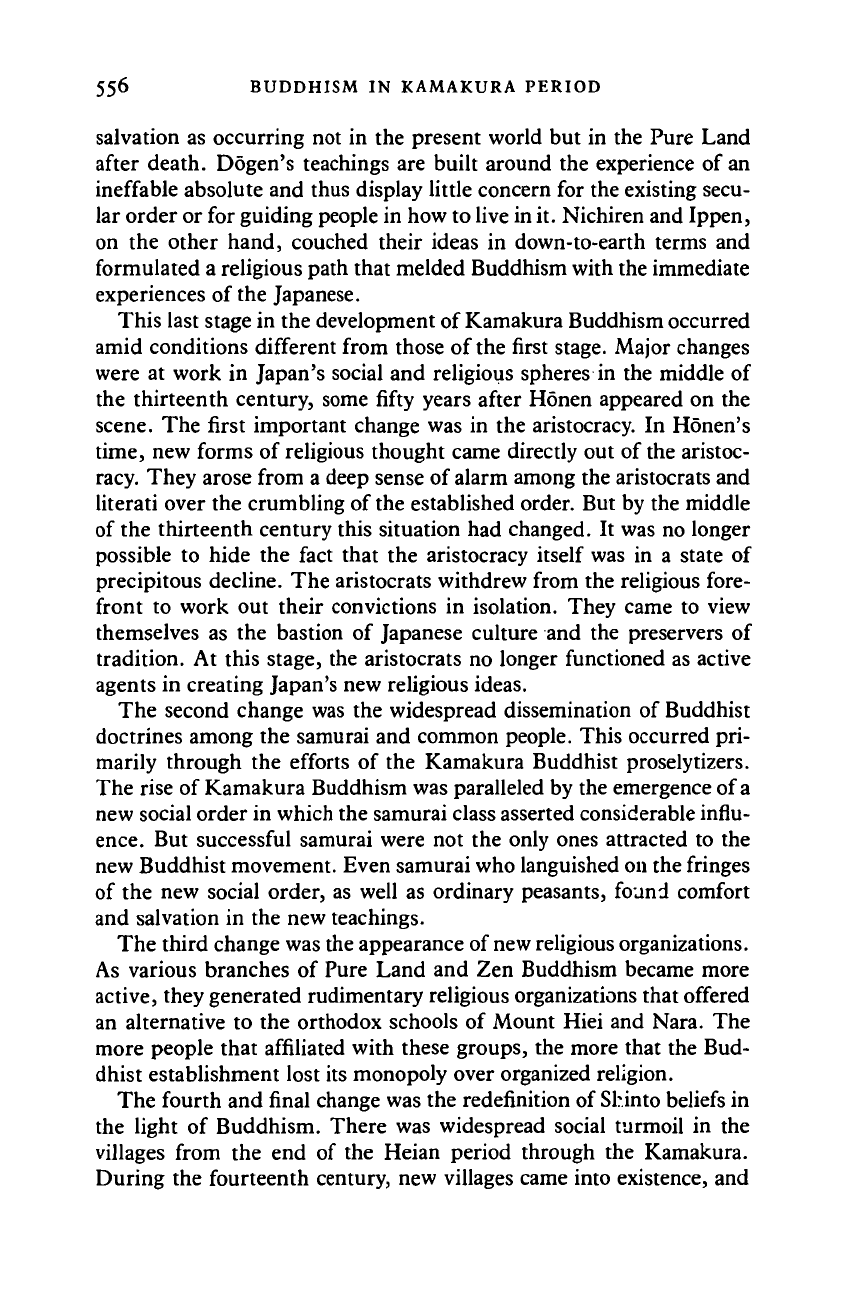
556 BUDDHISM IN KAMAKURA PERIOD
salvation as occurring not in the present world but in the Pure Land
after death. Dogen's teachings are built around the experience of an
ineffable absolute and thus display little concern for the existing secu-
lar order or for guiding people in how to live in it. Nichiren and Ippen,
on the other hand, couched their ideas in down-to-earth terms and
formulated a religious path that melded Buddhism with the immediate
experiences of the Japanese.
This last stage in the development of Kamakura Buddhism occurred
amid conditions different from those of the first stage. Major changes
were at work in Japan's social and religious spheres in the middle of
the thirteenth century, some fifty years after Honen appeared on the
scene. The first important change was in the aristocracy. In Honen's
time,
new forms of religious thought came directly out of the aristoc-
racy. They arose from a deep sense of alarm among the aristocrats and
literati over the crumbling of the established order. But by the middle
of the thirteenth century this situation had changed. It was no longer
possible to hide the fact that the aristocracy itself was in a state of
precipitous decline. The aristocrats withdrew from the religious fore-
front to work out their convictions in isolation. They came to view
themselves as the bastion of Japanese culture and the preservers of
tradition. At this stage, the aristocrats no longer functioned as active
agents in creating Japan's new religious ideas.
The second change was the widespread dissemination of Buddhist
doctrines among the samurai and common people. This occurred pri-
marily through the efforts of the Kamakura Buddhist proselytizers.
The rise of Kamakura Buddhism was paralleled by the emergence of a
new social order in which the samurai class asserted considerable influ-
ence.
But successful samurai were not the only ones attracted to the
new Buddhist movement. Even samurai who languished on the fringes
of the new social order, as well as ordinary peasants, found comfort
and salvation in the new teachings.
The third change was the appearance of new religious organizations.
As various branches of Pure Land and Zen Buddhism became more
active, they generated rudimentary religious organizations that offered
an alternative to the orthodox schools of Mount Hiei and Nara. The
more people that affiliated with these groups, the more that the Bud-
dhist establishment lost its monopoly over organized religion.
The fourth and final change was the redefinition of Shinto beliefs in
the light of Buddhism. There was widespread social turmoil in the
villages from the end of the Heian period through the Kamakura.
During the fourteenth century, new villages came into existence, and
Cambridge Histories Online © Cambridge University Press, 2008
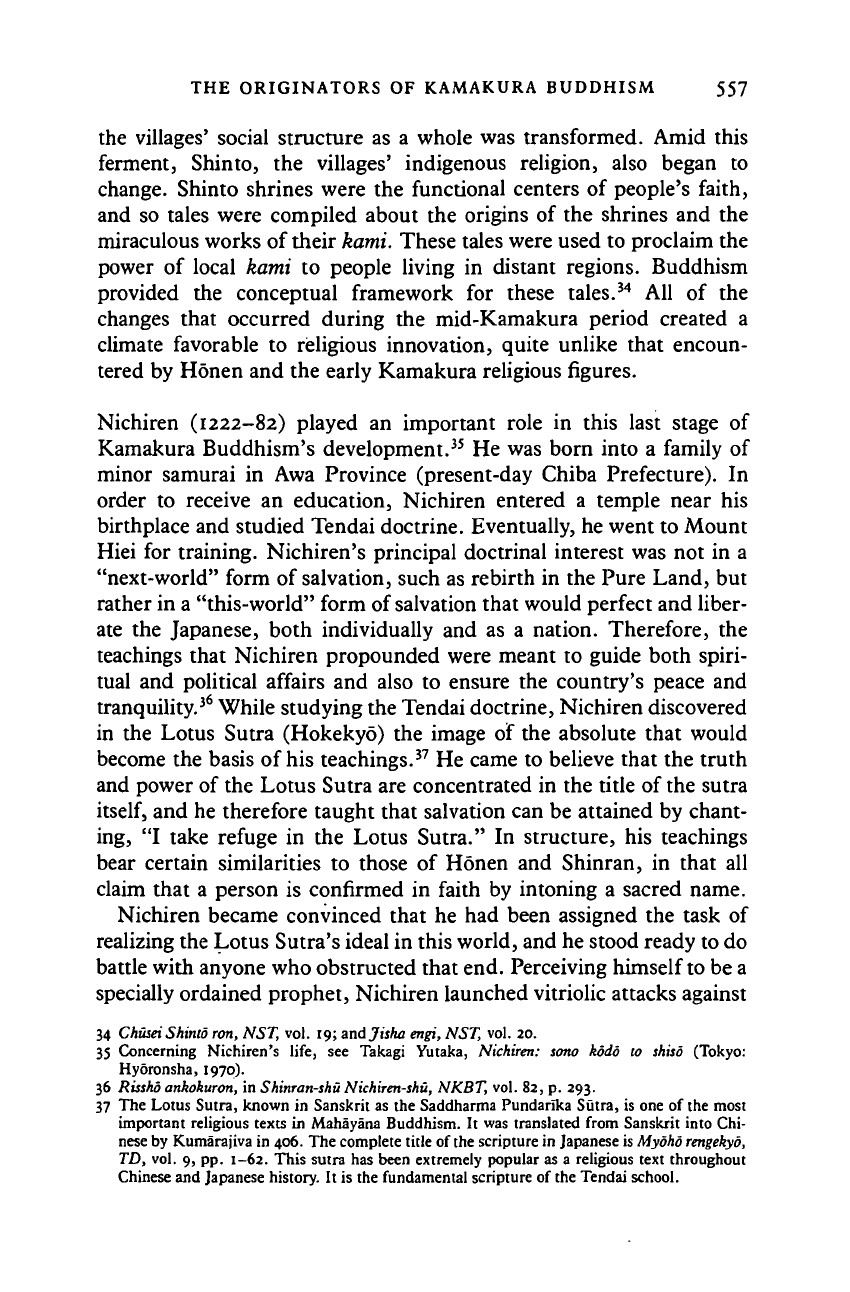
THE ORIGINATORS OF KAMAKURA BUDDHISM 557
the villages' social structure as a whole was transformed. Amid this
ferment, Shinto, the villages' indigenous religion, also began to
change. Shinto shrines were the functional centers of people's faith,
and so tales were compiled about the origins of the shrines and the
miraculous works of their
kami.
These tales were used to proclaim the
power of local kami to people living in distant regions. Buddhism
provided the conceptual framework for these tales.
34
All of the
changes that occurred during the mid-Kamakura period created a
climate favorable to religious innovation, quite unlike that encoun-
tered by Honen and the early Kamakura religious figures.
Nichiren (1222-82) played an important role in this last stage of
Kamakura Buddhism's development.
35
He was born into a family of
minor samurai in Awa Province (present-day Chiba Prefecture). In
order to receive an education, Nichiren entered a temple near his
birthplace and studied Tendai doctrine. Eventually, he went to Mount
Hiei for training. Nichiren's principal doctrinal interest was not in a
"next-world" form of salvation, such as rebirth in the Pure Land, but
rather in a "this-world" form of salvation that would perfect and liber-
ate the Japanese, both individually and as a nation. Therefore, the
teachings that Nichiren propounded were meant to guide both spiri-
tual and political affairs and also to ensure the country's peace and
tranquility.
36
While studying the Tendai doctrine, Nichiren discovered
in the Lotus Sutra (Hokekyo) the image of the absolute that would
become the basis of his teachings.
37
He came to believe that the truth
and power of the Lotus Sutra are concentrated in the title of the sutra
itself,
and he therefore taught that salvation can be attained by chant-
ing, "I take refuge in the Lotus Sutra." In structure, his teachings
bear certain similarities to those of Honen and Shinran, in that all
claim that a person is confirmed in faith by intoning a sacred name.
Nichiren became convinced that he had been assigned the task of
realizing the Lotus Sutra's ideal in this world, and he stood ready to do
battle with anyone who obstructed that end. Perceiving himself to be a
specially ordained prophet, Nichiren launched vitriolic attacks against
34 Chusei Shinto ron, NST, vol. 19; and Jiska engi, NST, vol. 20.
35 Concerning Nichiren's life, see Takagi Yutaka, Nichiren: sono kodo to shiso (Tokyo:
Hyoronsha, 1970).
36 Rissho ankokuron, in Shiman-shu Nichiren-shu,
NKBT,
vol. 82, p. 293.
37 The Lotus Sutra, known in Sanskrit as the Saddharma Pundarika Sutra, is one of the most
important religious texts in Mahayana Buddhism. It was translated from Sanskrit into Chi-
nese by Kumarajiva in 406. The complete title of the scripture in Japanese is Mydho
rengekyo,
TD, vol. 9, pp. 1-62. This sutra has been extremely popular as a religious text throughout
Chinese and Japanese history. It is the fundamental scripture of the Tendai school.
Cambridge Histories Online © Cambridge University Press, 2008
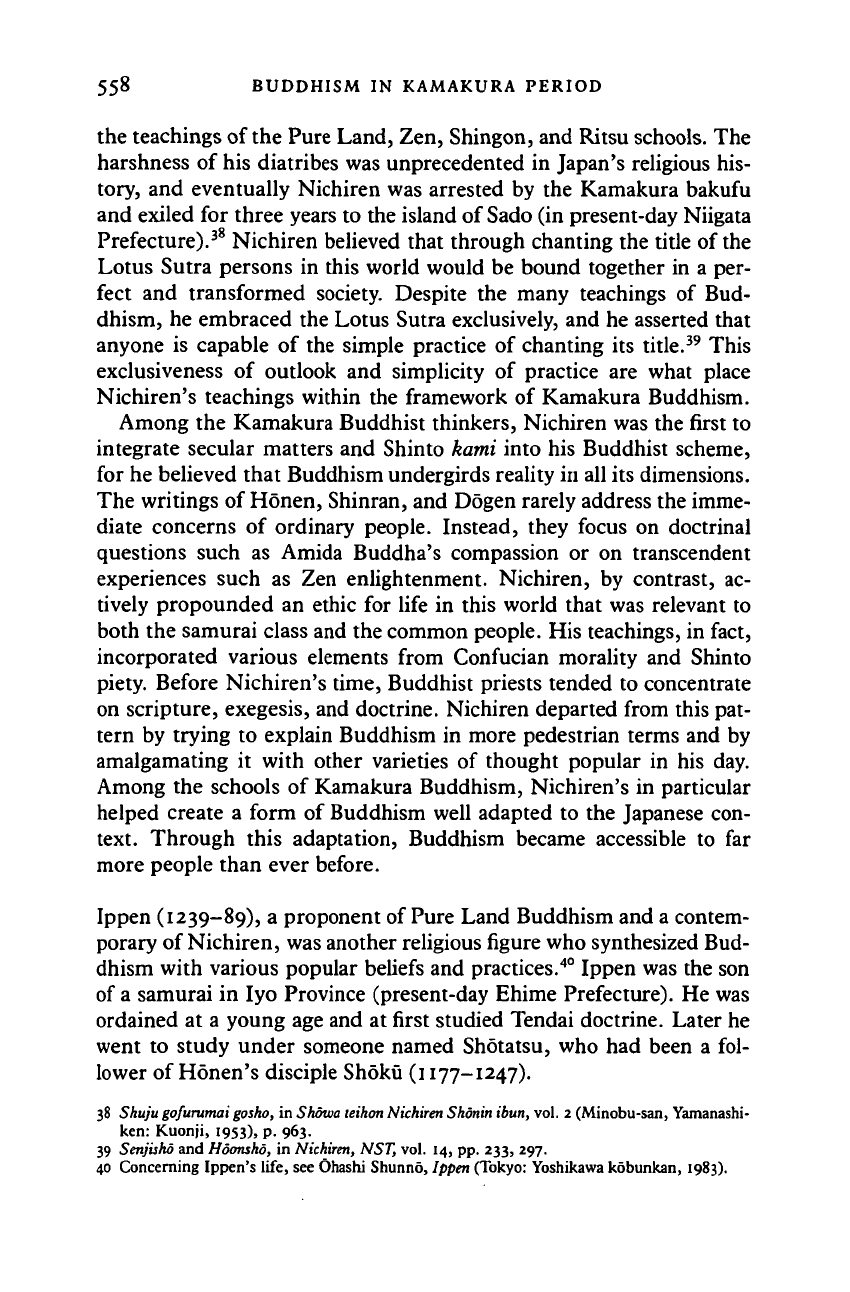
558 BUDDHISM IN KAMAKURA PERIOD
the teachings of the Pure Land, Zen, Shingon, and Ritsu schools. The
harshness of his diatribes was unprecedented in Japan's religious his-
tory, and eventually Nichiren was arrested by the Kamakura bakufu
and exiled for three years to the island of Sado (in present-day Niigata
Prefecture).
38
Nichiren believed that through chanting the title of the
Lotus Sutra persons in this world would be bound together in a per-
fect and transformed society. Despite the many teachings of Bud-
dhism, he embraced the Lotus Sutra exclusively, and he asserted that
anyone is capable of the simple practice of chanting its title.
39
This
exclusiveness of outlook and simplicity of practice are what place
Nichiren's teachings within the framework of Kamakura Buddhism.
Among the Kamakura Buddhist thinkers, Nichiren was the first to
integrate secular matters and Shinto kami into his Buddhist scheme,
for he believed that Buddhism undergirds reality in all its dimensions.
The writings of Honen, Shinran, and Dogen rarely address the imme-
diate concerns of ordinary people. Instead, they focus on doctrinal
questions such as Amida Buddha's compassion or on transcendent
experiences such as Zen enlightenment. Nichiren, by contrast, ac-
tively propounded an ethic for life in this world that was relevant to
both the samurai class and the common people. His teachings, in fact,
incorporated various elements from Confucian morality and Shinto
piety. Before Nichiren's time, Buddhist priests tended to concentrate
on scripture, exegesis, and doctrine. Nichiren departed from this pat-
tern by trying to explain Buddhism in more pedestrian terms and by
amalgamating it with other varieties of thought popular in his day.
Among the schools of Kamakura Buddhism, Nichiren's in particular
helped create a form of Buddhism well adapted to the Japanese con-
text. Through this adaptation, Buddhism became accessible to far
more people than ever before.
Ippen (1239-89), a proponent of Pure Land Buddhism and a contem-
porary of Nichiren, was another religious figure who synthesized Bud-
dhism with various popular beliefs and practices.
40
Ippen was the son
of a samurai in Iyo Province (present-day Ehime Prefecture). He was
ordained at a young age and at first studied Tendai doctrine. Later he
went to study under someone named Shotatsu, who had been a fol-
lower of Honen's disciple Shoku (1177-1247).
38 Shuju gofurumai
gosho,
in Showa leihon Nichiren Shdnin ibun, vol. 2 (Minobu-san, Yamanashi-
ken: Kuonji, 1953), p. 963.
39 Senjisho and Hoonsho, in Nichiren, NST, vol. 14, pp. 233, 297.
40 Concerning Ippen's life, see Ohashi Shunno, Ippen (Tokyo: Yoshikawa kobunkan, 1983).
Cambridge Histories Online © Cambridge University Press, 2008
